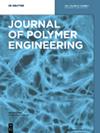用单体前驱体交联法制备铜离子吸附效率更高的导电聚合物基吸附剂
IF 1.7
4区 工程技术
Q4 POLYMER SCIENCE
引用次数: 0
摘要
基于导电聚合物的吸附剂具有出色的重金属离子去除能力。交联改性是进一步提高其性能的可行方法之一。为了发挥单体前驱体法相对于聚合物前驱体法在形成致密互穿网络方面的优势,进而优化材料的表面结构,提供更多的吸附位点,利用前者制备了介孔交联聚邻苯二胺(M-CR-PoPD),并将其用于去除水溶液中的 Cu2+。傅立叶变换红外光谱结果表明,单体已成功交联聚合。成功形成了具有分层孔隙结构分布的松散堆积目标产物。以无水乙醇为溶剂,以三羟甲基丙烷-三(3-氮丙啶基)丙酸酯为交联剂,在反应时间为 6 小时的情况下制备 M-CR-PoPD,在 25 °C 下吸附 3 小时后,吸附容量达到最大值 105.18 mg g-1。该值达到了已报道的基于 PoPD 的吸附剂的最佳 Cu2+ 去除能力。根据吸附前后的 EDX、FTIR 和 XPS 数据,提出了基于阳离子-π 相互作用和 Cu-N 键形成的可能吸附机制。这些结果有助于开发更有效的基于导电聚合物的吸附剂,以去除废水中的 Cu2+。本文章由计算机程序翻译,如有差异,请以英文原文为准。
Preparing conductive polymer-based adsorbent with better cupric ion adsorption efficiency by monomer precursor cross-linking method
Conductive polymer-based adsorbents have showed excellent heavy metal ion removing capabilities. Crosslinking modification is one of the feasible methods to further improve their properties. To make use of the advantages of monomer precursor method over the polymer precursor method in forming dense interpenetrating networks, and then optimizing the surface structure of materials and providing more adsorption sites, the mesoporous cross-linked poly-o-phenylenediamine (M-CR-PoPD) prepared by using the former one and used in removing Cu2+ from aqueous solution. The FTIR results showed that the monomer was successfully crosslinked and polymerized. The loosely packed target product with a hierarchical pore structure distribution was successfully formed. The maximum adsorption capacity of 105.18 mg g−1 was obtained at 25 °C after 3 h of adsorption when M-CR-PoPD prepared at the reaction time of 6 h using anhydrous ethanol as solvent and trimethylolpropane-tris(3-aziridinyl) propionate as crosslinking agent. This value reached the optimum Cu2+ removal capability of reported PoPD-based adsorbents. According to EDX, FTIR, and XPS data before and after adsorption, the possible adsorption mechanism based on the cation-π interaction and the formation of Cu–N bonds was proposed. These results could help develop more effective conductive polymer-based adsorbents to remove Cu2+ from wastewater.
求助全文
通过发布文献求助,成功后即可免费获取论文全文。
去求助
来源期刊

Journal of Polymer Engineering
工程技术-高分子科学
CiteScore
3.20
自引率
5.00%
发文量
95
审稿时长
2.5 months
期刊介绍:
Journal of Polymer Engineering publishes reviews, original basic and applied research contributions as well as recent technological developments in polymer engineering. Polymer engineering is a strongly interdisciplinary field and papers published by the journal may span areas such as polymer physics, polymer processing and engineering of polymer-based materials and their applications. The editors and the publisher are committed to high quality standards and rapid handling of the peer review and publication processes.
 求助内容:
求助内容: 应助结果提醒方式:
应助结果提醒方式:


